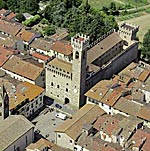
With the opening of the Giogo road towards Emilia, the fortified town grew in importance with the appointment of a podestà named by the Florentine Republic as of 1376. In 1415, it became the seat of the vicariate, acquiring a pre-eminent role in respect to the other Mugello settlements. This Florentine official, who resided in the beautiful turreted palace, held civil power over the Scarperia territory and penal power over the vicariate, which included various podesterias.
Further evidence of Scarperia’s administrative function is particularly demonstrated by the rich collection of coats-of-arms placed there – and especially on the palace façade – by the vicari, or deputies, at the end of their six-month mandate. Among the many in various shapes, both in stone and marble with very rare traces of the original colors, and those in glazed polychrome terracotta (the latter, concentrated on the left of the façade, from the Buglioni workshop at the end of the 15th and beginning of the 16th centuries), notice must be taken of the terracotta one of the humanist Giannozzo Manetti, deputy in 1452, which is set to the left of the entrance portal. At one time fully painted, it has two cupids which are embracing.
In the first atrium, there is the large 1546 cartouche-shaped coat-of-arms of Cosimo de’ Medici, surmounted by the ducal crown in testimony of the regime’s change from a republic to a principality. In the second atrium – also vaulted – are mostly found the painted coats-of-arms of the first deputies. One of the most ancient (1418) is that of Piero Lapozzi, with a two-headed, winged dragon as a crest, on the left wall.
In the vault groin that corresponds to the access arch to the upper floor is the painted coat-of-arms of the humanist Matteo Palmieri, deputy in 1455. It is set in a garland and specifically characterized by two green palmettes. It confirms the great importance of the citizens who held that appointment. Finally, also on the same wall, in the last lunette towards the courtyard, are frescoes with the “armorial bearings of the community” (those of People, of the city of Florence and of the Guelph party) that underscore the political importance of this public space inside the palace.
Chapel
In the past, this room served as a chapel, thus the fresco of the Madonna with Child Enthroned between Saints John the Baptist and Francis to the left and John the Evangelist and Dominic to the right, set within a frame painted in the style of those, either wooden or stone, which held altarpieces. On the frieze of the trabeation, there are cherub heads alternated with palmettes; the coat-of-arms of the patron, Giovanni di Bardo di Guglielmo Altoviti, deputy in 1501, is seen on the pilasters. The inscription at the feet of the figures records the restoration carried out in 1554.
There are three clipei, alternated with faux marble panels, on the predella. The center one depicts an Ecce Homo with the Archangel Raphael and Tobiolo and the Magdalene to the sides. The work has been attributed to Piero del Donzello, an artist similar in style to Domenico Ghirlandaio. All the walls are decorated with the deputies’ coats-of-arms and the dates related to their appointments. On the lower band of the walls are traces of a drapery-like decoration.
Council Room
Thanks to the generosity of Marquis Filippo Sassoli de’ Bianchi, the mayor of Scarperia at that time, a vast campaign of restoration was undertaken following the 1919 earthquake. As the inscription under the patron’s coat-of-arms to the left of the fireplace states, this room too was returned to its original aspect and inaugurated in 1926. On the wall dividing this room from the chapel, there is a stone washbasin set in a niche closed by wooden doors. Above the door, there is a frescoed Crucifixion datable to between the end of the 14th century and the early years of the 15th; it has the late-Giottesque style of Niccolò di Pietro Gerini or Pietro Nelli.
On the long walls, a frieze of coats-of-arms runs under the flat ceiling. In the middle area, rich festoons are interwoven with ribbons from which other vicarial blazons hang. The lower band of the walls instead displays faux drapery. One of the two long walls has a fireplace in pietra serena, donated on the occasion of the 20th-century restorations. A detached fresco resting on the mantelpiece is from the second atrium and bears the coat-of-arms of Scarperia’s podesteria; it depicts Saint Barnabas, after whom the “terra nuova” had been named.
On the other long wall, there are three doors surmounted by gables, in two of which are painted Saint Francis and Saint Lawrence, commissioned by Francesco di Lorenzo Davanzati, deputy in 1509. Finally, on the wall with the two windows, around which elegant grotesques unfold, is the coat-of-arms of Mariotto di Lorenzo Steccati, deputy in 1575.
Medici in Arms
The Medici between Florence and the Mugello: a Chronology
Arms and Armor
The Medici between Florence and the Mugello: a Chronology
Arms and Armor